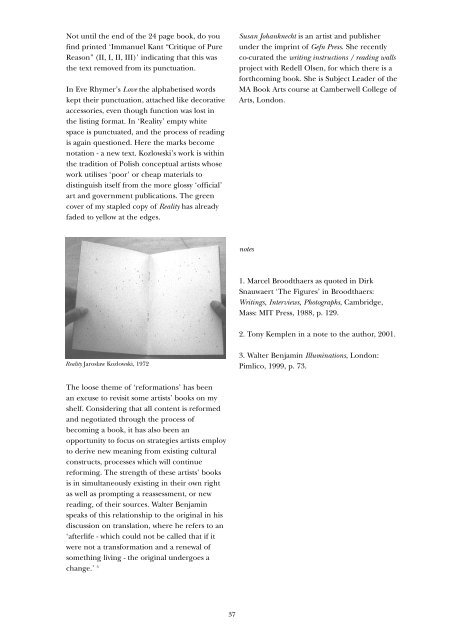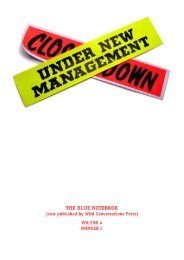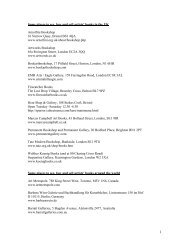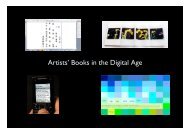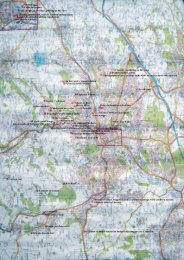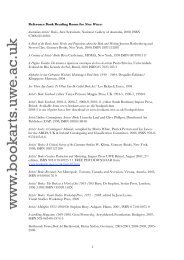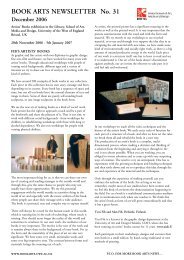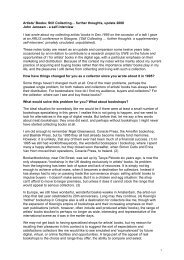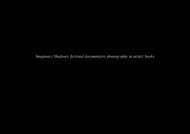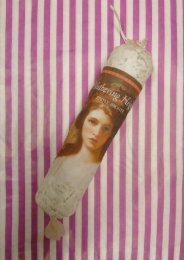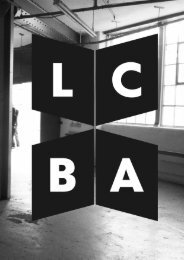Artist's Book Yearbook 2003-2005 - Book Arts - University of the ...
Artist's Book Yearbook 2003-2005 - Book Arts - University of the ...
Artist's Book Yearbook 2003-2005 - Book Arts - University of the ...
You also want an ePaper? Increase the reach of your titles
YUMPU automatically turns print PDFs into web optimized ePapers that Google loves.
Not until <strong>the</strong> end <strong>of</strong> <strong>the</strong> 24 page book, do you<br />
find printed ‘Immanuel Kant “Critique <strong>of</strong> Pure<br />
Reason” (II, I, II, III)’ indicating that this was<br />
<strong>the</strong> text removed from its punctuation.<br />
In Eve Rhymer’s Love <strong>the</strong> alphabetised words<br />
kept <strong>the</strong>ir punctuation, attached like decorative<br />
accessories, even though function was lost in<br />
<strong>the</strong> listing format. In ‘Reality’ empty white<br />
space is punctuated, and <strong>the</strong> process <strong>of</strong> reading<br />
is again questioned. Here <strong>the</strong> marks become<br />
notation - a new text. Kozlowski’s work is within<br />
<strong>the</strong> tradition <strong>of</strong> Polish conceptual artists whose<br />
work utilises ‘poor’ or cheap materials to<br />
distinguish itself from <strong>the</strong> more glossy ‘<strong>of</strong>ficial’<br />
art and government publications. The green<br />
cover <strong>of</strong> my stapled copy <strong>of</strong> Reality has already<br />
faded to yellow at <strong>the</strong> edges.<br />
Reality Jaroslaw Kozlowski, 1972<br />
The loose <strong>the</strong>me <strong>of</strong> ‘reformations’ has been<br />
an excuse to revisit some artists’ books on my<br />
shelf. Considering that all content is reformed<br />
and negotiated through <strong>the</strong> process <strong>of</strong><br />
becoming a book, it has also been an<br />
opportunity to focus on strategies artists employ<br />
to derive new meaning from existing cultural<br />
constructs, processes which will continue<br />
reforming. The strength <strong>of</strong> <strong>the</strong>se artists’ books<br />
is in simultaneously existing in <strong>the</strong>ir own right<br />
as well as prompting a reassessment, or new<br />
reading, <strong>of</strong> <strong>the</strong>ir sources. Walter Benjamin<br />
speaks <strong>of</strong> this relationship to <strong>the</strong> original in his<br />
discussion on translation, where he refers to an<br />
‘afterlife - which could not be called that if it<br />
were not a transformation and a renewal <strong>of</strong><br />
something living - <strong>the</strong> original undergoes a<br />
change.’ 3<br />
37<br />
Susan Johanknecht is an artist and publisher<br />
under <strong>the</strong> imprint <strong>of</strong> Gefn Press. She recently<br />
co-curated <strong>the</strong> writing instructions / reading walls<br />
project with Redell Olsen, for which <strong>the</strong>re is a<br />
forthcoming book. She is Subject Leader <strong>of</strong> <strong>the</strong><br />
MA <strong>Book</strong> <strong>Arts</strong> course at Camberwell College <strong>of</strong><br />
<strong>Arts</strong>, London.<br />
notes<br />
1. Marcel Broodthaers as quoted in Dirk<br />
Snauwaert ‘The Figures’ in Broodthaers:<br />
Writings, Interviews, Photographs, Cambridge,<br />
Mass: MIT Press, 1988, p. 129.<br />
2. Tony Kemplen in a note to <strong>the</strong> author, 2001.<br />
3. Walter Benjamin Illuminations, London:<br />
Pimlico, 1999, p. 73.


